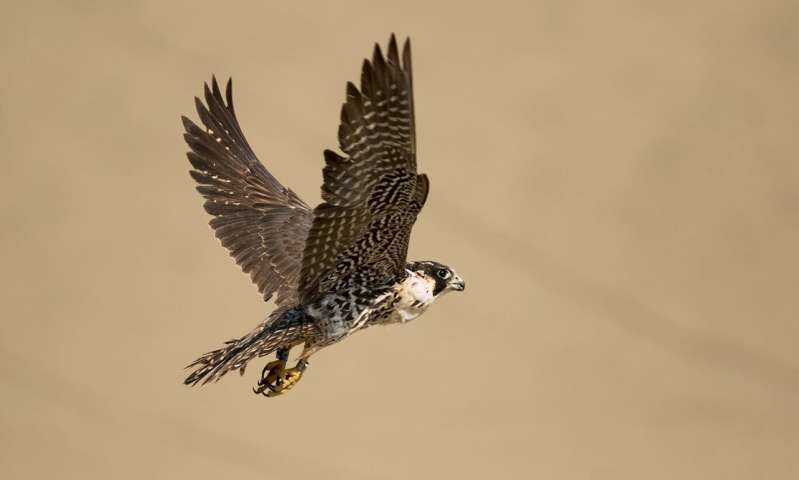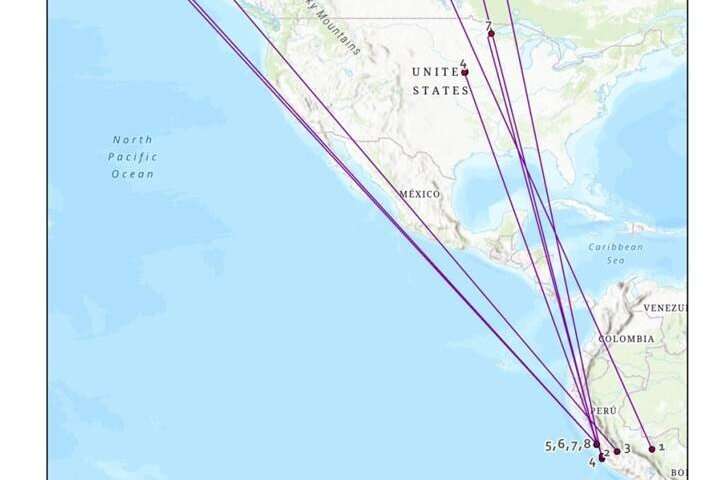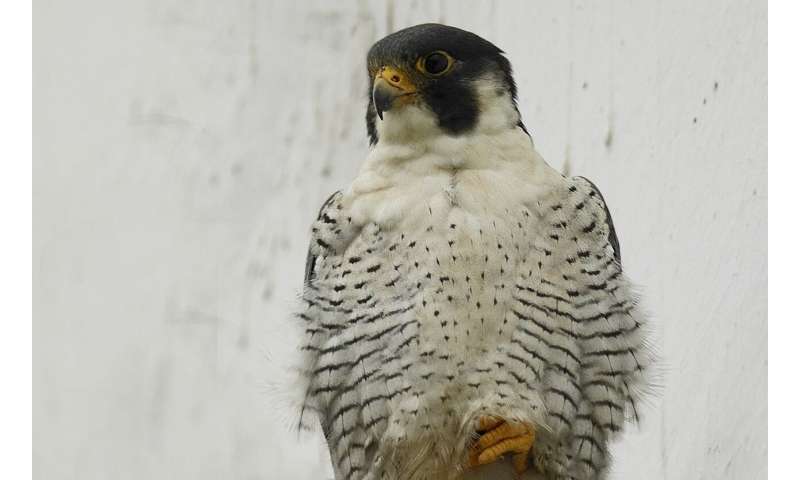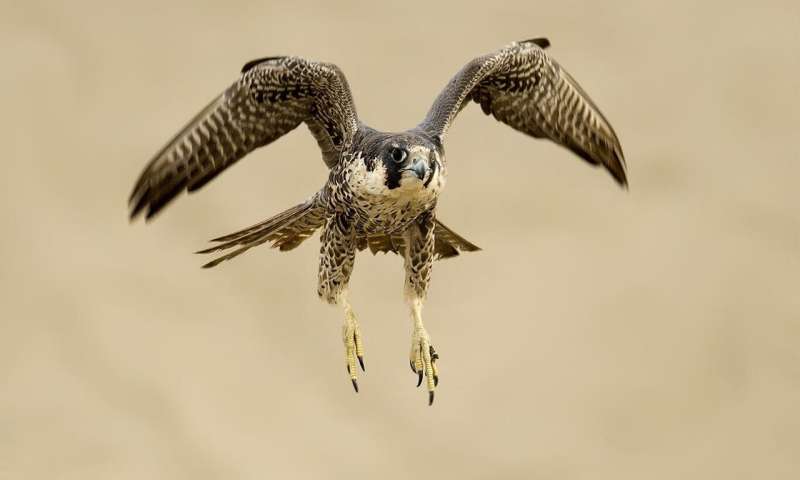Charting the long-distance migrations of the world's fastest bird

The world's fastest birds, peregrine falcons, disappear from their North American nesting grounds for up to seven months at a time. But where do they go? We used data from 227 North American peregrines over a 57-year period, including 21 banded birds, to show that the world's fastest birds also compete in long-distance flight!
"True to their name, which means 'pilgrim' or 'wanderer,' peregrines wintering in Peru come from nesting areas across North America, from Alaska to Greenland," explained lead author Oscar Beingolea.
One peregrine migrated 8870 km from Canada's Hudson Bay only to crash through the skylight of a high-rise building while pursuing a dove in the Peruvian capital of Lima. Residents found her eating her prey in a stairwell. Police contacted a falconer, Álvaro García, who safely captured the bird and released her outside, unharmed.
Sky King, a peregrine released in Nebraska by a peregrine restoration program, flew more than 6,430 km to a beach in Peru—the farthest known migration of a captive-bred peregrine. And a Minnesota falcon, hatched in the wild by two captive-bred parents, clocked at least 6,760 km. But the record is held by an Alaska peregrine hatched in the Arctic tundra and found wintering on the Peruvian coast—a flight of over 10,670 km!

High dispersal, high fidelity
Wanderers that they are, peregrines demonstrate extreme flexibility and opportunism in their ability to scatter to a highly variable range of destinations and survive. Peregrines thrive even in environments hostile to most other wildlife, including major cities like Chicago, Canadian taiga and Peruvian coastal desert.
While highly dispersive on a population level, individual peregrines often display high site fidelity, returning repeatedly to the same breeding and wintering sites. Sky King, for example, the peregrine from Nebraska we found wintering in Peru, returned repeatedly to Nebraska to nest. Likewise, Lima resident Martín Mispireta Robles observed an Arctic tundra peregrine faithfully return to the same wintering site in September year after year in Lima, and remain throughout the austral summer.
Differential migration: males migrate farther than females
"Nearly three-quarters of the peregrines we found wintering in Peru were male. Female peregrines, which are about 30% larger than males, tend to use different migration pathways and wintering areas—a phenomenon known as differential migration," Beingolea explained.

Although differential migration is known in many bird species, we have yet to discover how and why this phenomenon evolved. The pattern, however, is clear: Male peregrines often fly two to four times farther on migration than their female counterparts, with females predominantly stopping in Central America while most males continue to South America.
Climate change and the timing of bird migration
Many birds' spring and autumn migration dates have been advancing in response to climate change. Thanks to a network of Peruvian citizen scientists, we found that peregrines are no exception to this trend, and appear be arriving up to three weeks earlier on their wintering grounds now compared to previous decades.
This is one more example of peregrines' remarkable flexibility, which played an important role in enabling their successful comeback after their populations plummeted due to pesticide poisoning starting in the 1940s. The Canadian and American governments recognized peregrines as endangered species in 1970, and took the critical step of banning the pesticide DDT in 1970 and 1972, respectively, opening the door to peregrines' recovery.
Racing against time to save peregrines from extinction, conservationists released thousands of captive-bred falcons into the wild in an effort to bring the birds back. By 1999, the population had grown to the point that they could be removed from the federal endangered species list.

Something to celebrate
Peregrines' successful recovery from endangered species status is a tribute to the thousands of people who played a part in saving them from extinction. It is also a tribute to the resilience and power of the birds themselves.
"To realize that these birds, which have made such a spectacular comeback, regularly cover such enormous distances was truly stunning," Beingolea said.
"It makes you realize how much we still have to discover, even about some of the most celebrated birds in the world."
This story is part of Science X Dialog, where researchers can report findings from their published research articles. Visit this page for information about ScienceX Dialog and how to participate.
More information:
Beingolea & Arcilla, Linking Peregrine Falcons' Wintering Areas in Peru with their North American Natal and Breeding Grounds, Journal of Raptor Research (2020). DOI: 10.3356/JRR-19-0008
, meridian.allenpress.com/rapt/a … ons-Falco-peregrinus
Bio:
Nico Arcilla is president and research director of the International Bird Conservation Partnership, which fosters and supports research, education, and partnerships to promote the conservation of birds worldwide. She earned her BA from Yale University, MS from Cornell University, and PhD from the University of Georgia, and has held positions at the Smithsonian Institution, Zoological Society of London, and Drexel University. Peru's foremost authority on peregrine falcons, Oscar Beingolea's research and writing have informed numerous publications on raptor behavior, natural history, breeding biology, and migration. In 2020, the Raptor Research Foundation established an annual grant in Oscar's name to assist others in continuing his legacy of advancing our knowledge of birds of prey in Latin America and the Caribbean.